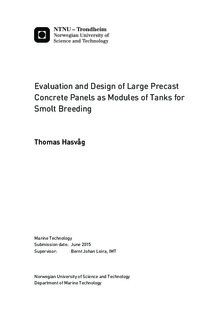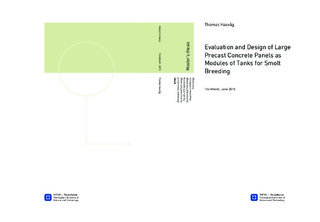| dc.description.abstract | With increasing permissions for onshore smolt breeding, the industry may long for solutions that are competitive and robust. A part of this demand relates to breeding tanks that should be able to handle the given quantity of smolt, while holding the costs of construction within reasonable limits. Concrete is a high-strength material well suited for increasing structural requirements. Reinforced by steel, the composite may be given characteristics beneficial for a tank in this environment.
Precast concrete states a production method creating the structural elements prior to the mounting. A part of the work is then performed at fabrication halls within a stable environment, which may reduce the overall time of deliverance. Although the use raises additional issues related to transportation and installation, reinforced concrete panels is potentially a competitive solution as modules in a tank used for smolt breeding.
The demand for an optimized smolt breeding plant may encourage the use of larger concrete panels. In order to still remain functional, the tank could be strengthened by application of prestressed steel within each panel. As concrete possess low tensile strength leading to crack formulations, prestressing is an efficient tool in providing a watertight structure.
The thesis investigates buckling limits with respect to the application of prestress. With increasing span-ratio and decreasing panel thickness, this may become an upper bound for its use. Buckling analyses are performed within the three following stages in the construction.
Vertical prestressing in fabric, i.e panel subjected to compressive stress at short edges
Further prestressing at site along the perimeter, i.e panel subjected to biaxial compression
Design condition, i.e biaxially compressed panel subjected to hydrostatic pressure
A design of the largest panel followed throughout the study is then proposed. The procedure governs the utilization of prestressed steel within a slab in two-way flexural action so to limit formulation of cracks. According to \citet{Liquid} for a completely watertight structure, this is fulfilled by maintaining a certain zone of compression within the panel.
For the proposed design, the equivalent compressive forces from prestressing do not violate the corresponding buckling limits. However, as a panel within the first stage of construction shows a considerable low buckling capacity, this may become a design issue for slender panels.
The design is further approved by a finite element analysis in Etabs. While the appearing stresses are reasonable regarding concrete compressive capacity, the maximum deflection of the panel turns out as a governing issue. An improved solution should then really iterate on the prestressed design in order to fulfill this requirement. | |

